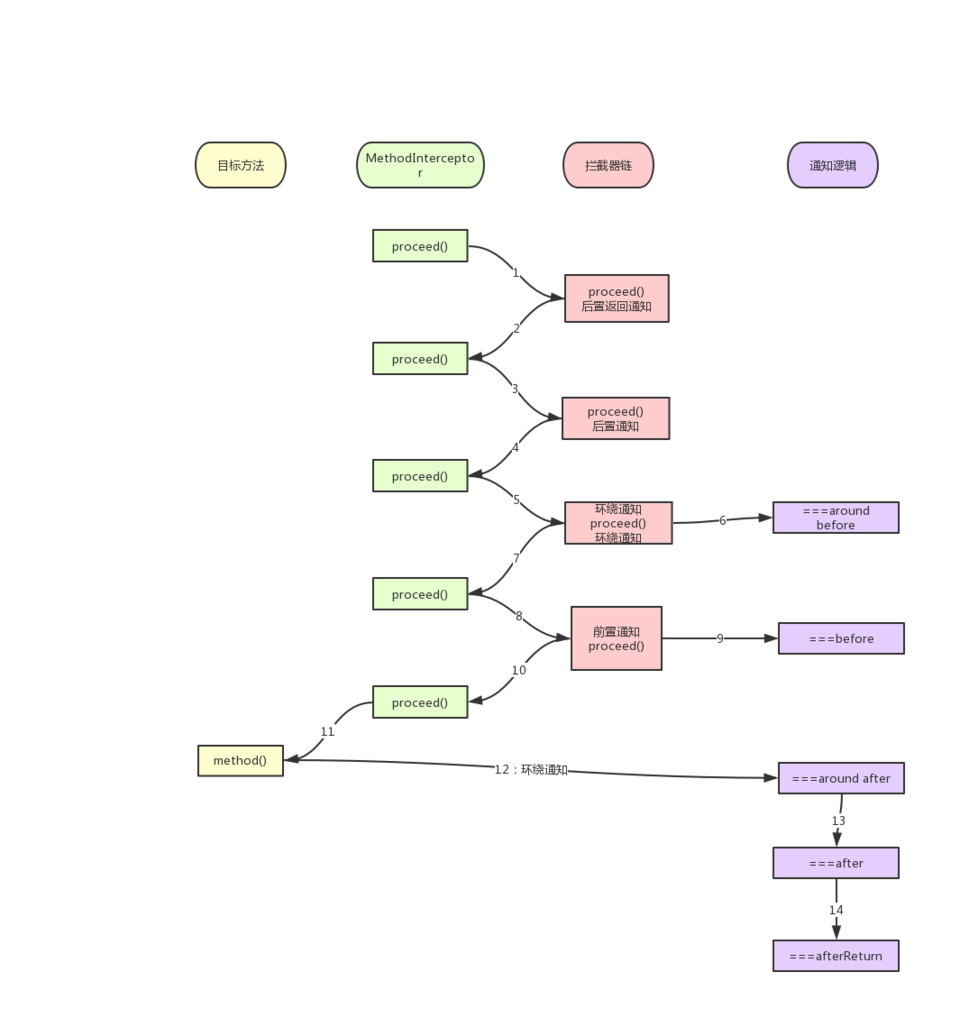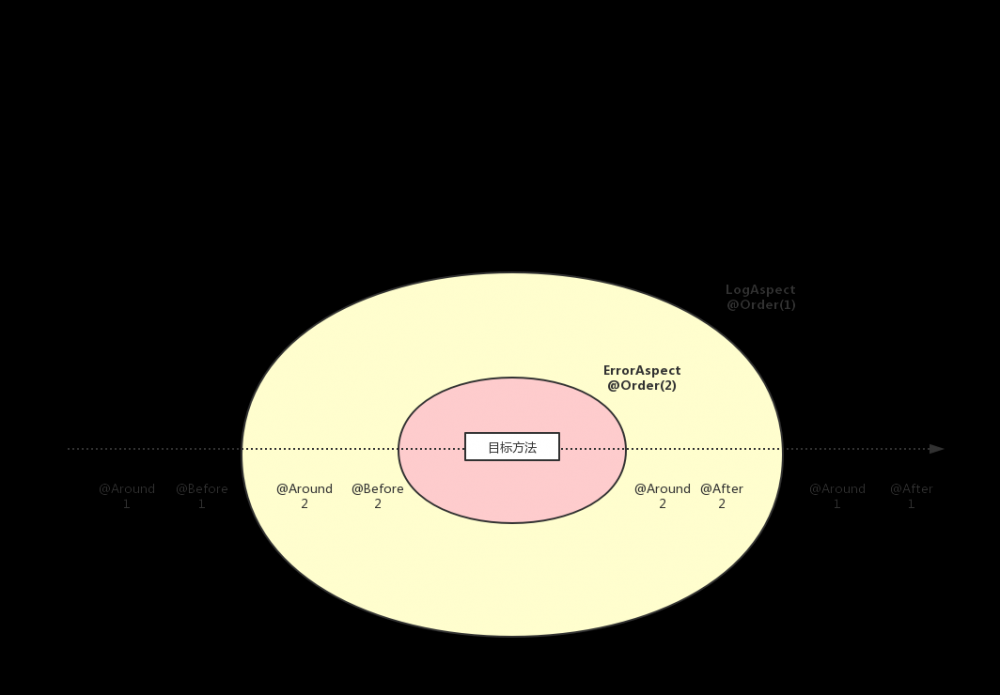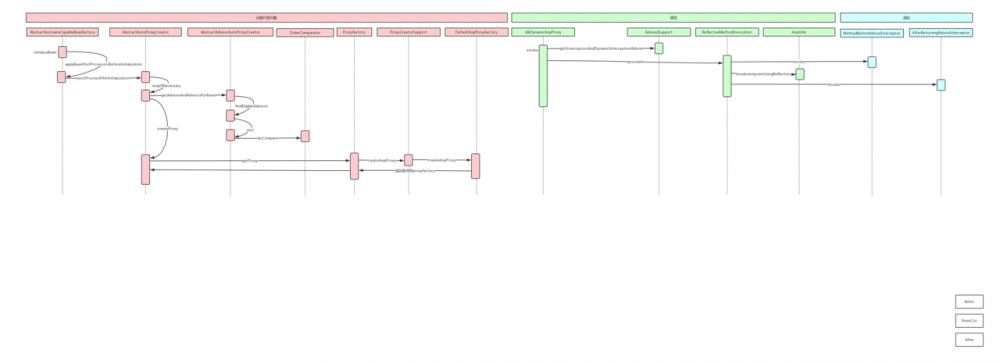SpringAop源码分析(基于注解)四:拦截器链
在之前的文章我们分析了通知器的创建与筛选和AOP创建代理对象的过程,现在代理对象已经有了,接下来我们看一下是如何执行通知器的逻辑的。
前言
通过阅读这篇文章,可以了解到以下几个问题:
- 通知的是如何起作用的?
- 多个通知的执行顺序是怎样的?
- 多个切面的多个通知的执行顺序是怎样的?
- @Transactional注解,调用本类方法为什么不起作用?
下面我们可以带着这些疑问来看
一、invoke()
本文依据 JdkDynamicAopProxy 来分析,对CGLIB感兴趣的同学看一看 ObjenesisCglibAopProxy 相关代码。 JdkDynamicAopProxy实现了 InvocationHandler 接口,我们来看下 invoke() 方法:
//JdkDynamicAopProxy.java
public Object invoke(Object proxy, Method method, Object[] args) throws Throwable {
MethodInvocation invocation;
Object oldProxy = null;
boolean setProxyContext = false;
TargetSource targetSource = this.advised.targetSource;
Object target = null;
try {
//如果目标对象没有定义equals()方法的话,就会直接调用而不会增强
<1> if (!this.equalsDefined && AopUtils.isEqualsMethod(method)) {
// The target does not implement the equals(Object) method itself.
return equals(args[0]);
}
//如果目标对象没有定义hashCode()方法的话,就会直接调用而不会增强
else if (!this.hashCodeDefined && AopUtils.isHashCodeMethod(method)) {
// The target does not implement the hashCode() method itself.
return hashCode();
}
else if (method.getDeclaringClass() == DecoratingProxy.class) {
// There is only getDecoratedClass() declared -> dispatch to proxy config.
return AopProxyUtils.ultimateTargetClass(this.advised);
}
//Advised接口或者其父接口中定义的方法,直接反射调用,不应用通知
else if (!this.advised.opaque && method.getDeclaringClass().isInterface() &&
method.getDeclaringClass().isAssignableFrom(Advised.class)) {
// Service invocations on ProxyConfig with the proxy config...
return AopUtils.invokeJoinpointUsingReflection(this.advised, method, args);
}
Object retVal;
// 如果 exposeProxy 属性为 true,则暴露代理对象
// exposeProxy 是 @EnableAspectJAutoProxy 注解的属性之一
<2> if (this.advised.exposeProxy) {
// Make invocation available if necessary.
// 向 AopContext 中设置代理对象
oldProxy = AopContext.setCurrentProxy(proxy);
setProxyContext = true;
}
//获得目标对象的类
<3> target = targetSource.getTarget();
Class<?> targetClass = (target != null ? target.getClass() : null);
//获取可以应用到此方法上的 Interceptor 拦截器 列表,并且排序
<4> List<Object> chain = this.advised.getInterceptorsAndDynamicInterceptionAdvice(method, targetClass);
//如果没有可以应用到此方法的通知(Interceptor),此直接反射调用 method.invoke(target, args)
<5> if (chain.isEmpty()) {
// We can skip creating a MethodInvocation: just invoke the target directly
// Note that the final invoker must be an InvokerInterceptor so we know it does
// nothing but a reflective operation on the target, and no hot swapping or fancy proxying.
Object[] argsToUse = AopProxyUtils.adaptArgumentsIfNecessary(method, args);
retVal = AopUtils.invokeJoinpointUsingReflection(target, method, argsToUse);
}
<6> else {
//创建 MethodInvocation,将拦截器链放入
invocation = new ReflectiveMethodInvocation(proxy, target, method, args, targetClass, chain);
// 执行拦截器链
retVal = invocation.proceed();
}
// 获取方法返回值类型
<7> Class<?> returnType = method.getReturnType();
if (retVal != null && retVal == target &&
returnType != Object.class && returnType.isInstance(proxy) &&
!RawTargetAccess.class.isAssignableFrom(method.getDeclaringClass())) {
// 如果方法返回值为 this,即 return this; 则将代理对象 proxy 赋值给 retVal
retVal = proxy;
}
// 如果返回值类型为基础类型,比如 int,long 等,当返回值为 null,抛出异常
else if (retVal == null && returnType != Void.TYPE && returnType.isPrimitive()) {
throw new AopInvocationException(
"Null return value from advice does not match primitive return type for: " + method);
}
return retVal;
}
finally {
if (target != null && !targetSource.isStatic()) {
// Must have come from TargetSource.
targetSource.releaseTarget(target);
}
if (setProxyContext) {
// Restore old proxy.
AopContext.setCurrentProxy(oldProxy);
}
}
}
复制代码
这个invoke()方法主要有以下几个步骤:
equals()、hashCode() exposeProxy
我们重点关注第<4>步和第<6>步,这两个地方非常重要,第<2>步涉及比较多,最后我们再分析,先来看下第<4>步。
1.1、获取可以应用到当前方法的拦截器链
代码:
//AdvisedSupport.java
public List<Object> getInterceptorsAndDynamicInterceptionAdvice(Method method, @Nullable Class<?> targetClass) {
MethodCacheKey cacheKey = new MethodCacheKey(method);
//从缓存中获取
List<Object> cached = this.methodCache.get(cacheKey);
if (cached == null) {
//获取所有的拦截器
cached = this.advisorChainFactory.getInterceptorsAndDynamicInterceptionAdvice(
this, method, targetClass);
this.methodCache.put(cacheKey, cached);
}
return cached;
}
复制代码
继续深入:
//DefaultAdvisorChainFactory.java
/**
* 从提供的配置实例config中获取advisor列表,遍历处理这些advisor.如果是IntroductionAdvisor,
* 则判断此Advisor能否应用到目标类targetClass上.如果是PointcutAdvisor,则判断
* 此Advisor能否应用到目标方法method上.将满足条件的Advisor通过AdvisorAdaptor转化成Interceptor列表返回.
*/
@Override
public List<Object> getInterceptorsAndDynamicInterceptionAdvice(
Advised config, Method method, @Nullable Class<?> targetClass) {
List<Object> interceptorList = new ArrayList<>(config.getAdvisors().length);
Class<?> actualClass = (targetClass != null ? targetClass : method.getDeclaringClass());
//查看是否包含IntroductionAdvisor
boolean hasIntroductions = hasMatchingIntroductions(config, actualClass);
//这里实际上注册一系列AdvisorAdapter,用于将 通知Advisor 转化成 方法拦截器MethodInterceptor
AdvisorAdapterRegistry registry = GlobalAdvisorAdapterRegistry.getInstance();
//遍历
for (Advisor advisor : config.getAdvisors()) {
if (advisor instanceof PointcutAdvisor) {
PointcutAdvisor pointcutAdvisor = (PointcutAdvisor) advisor;
//通过ClassFilter对当前Bean类型进行匹配
if (config.isPreFiltered() || pointcutAdvisor.getPointcut().getClassFilter().matches(actualClass)) {
//将 通知Advisor 转化成 拦截器Interceptor
MethodInterceptor[] interceptors = registry.getInterceptors(advisor);
MethodMatcher mm = pointcutAdvisor.getPointcut().getMethodMatcher();
//检查当前advisor的pointcut是否可以匹配当前方法
if (MethodMatchers.matches(mm, method, actualClass, hasIntroductions)) {
if (mm.isRuntime()) {
// Creating a new object instance in the getInterceptors() method
// isn't a problem as we normally cache created chains.
for (MethodInterceptor interceptor : interceptors) {
//加入拦截器链
interceptorList.add(new InterceptorAndDynamicMethodMatcher(interceptor, mm));
}
}
else {
//加入拦截器链
interceptorList.addAll(Arrays.asList(interceptors));
}
}
}
}
else if (advisor instanceof IntroductionAdvisor) {
IntroductionAdvisor ia = (IntroductionAdvisor) advisor;
// IntroductionAdvisor 类型的通知器,仅进行类级别的匹配即可
if (config.isPreFiltered() || ia.getClassFilter().matches(actualClass)) {
Interceptor[] interceptors = registry.getInterceptors(advisor);
interceptorList.addAll(Arrays.asList(interceptors));
}
}
else {
Interceptor[] interceptors = registry.getInterceptors(advisor);
interceptorList.addAll(Arrays.asList(interceptors));
}
}
return interceptorList;
}
复制代码
这里的主逻辑不是很复杂:
- 遍历所有通知器
- 对于 PointcutAdvisor 类型的通知器,这里要调用通知器所持有的切点(Pointcut)对类和方法进行匹配,匹配成功说明应向当前方法织入通知逻辑
- 将通知Advisor 转化成 拦截器Interceptor
- 返回拦截器数链
这里返回的拦截器链是 有序的 ,按照afterReturn、after、around、before排好序,(具体排序是在获取所有通知的时候 sortAdvisors(eligibleAdvisors) ),方便后面执行。
1.2、执行拦截器链
现在有了拦截器链,接下来再看下怎么执行的:
//ReflectiveMethodInvocation.java
//当前拦截器下标
private int currentInterceptorIndex = -1;
//拦截器链集合
protected final List<?> interceptorsAndDynamicMethodMatchers;
public Object proceed() throws Throwable {
// We start with an index of -1 and increment early.
// 拦截器链中的最后一个拦截器执行完
if (this.currentInterceptorIndex == this.interceptorsAndDynamicMethodMatchers.size() - 1) {
//执行目标方法
return invokeJoinpoint();
}
//每次执行新的拦截器,下标+1
Object interceptorOrInterceptionAdvice =
this.interceptorsAndDynamicMethodMatchers.get(++this.currentInterceptorIndex);
//如果要动态匹配切点
if (interceptorOrInterceptionAdvice instanceof InterceptorAndDynamicMethodMatcher) {
// Evaluate dynamic method matcher here: static part will already have
// been evaluated and found to match.
InterceptorAndDynamicMethodMatcher dm =
(InterceptorAndDynamicMethodMatcher) interceptorOrInterceptionAdvice;
// 如果是动态切点,需要进行参数匹配,以确定是否需要执行该动态横切逻辑
if (dm.methodMatcher.matches(this.method, this.targetClass, this.arguments)) {
return dm.interceptor.invoke(this);
}
else {
//动态切点匹配失败,略过当前Intercetpor,调用下一个Interceptor
return proceed();
}
}
else {
//执行当前Intercetpor
return ((MethodInterceptor) interceptorOrInterceptionAdvice).invoke(this);
}
}
复制代码
proceed 根据 currentInterceptorIndex 按照倒序执行拦截器链,每次执行完+1,当所有拦截器执行完后,再执行目标方法。 这里我们可以提出几个疑问:
- 当一方法匹配了多个通知时,不同通知之间是按照什么顺序来执行的?
- 从代码上看,所有通知都执行完毕后才会执行目标方法,那后置通知又是如何实现的?
我们带着这2个疑问往下看,
proceed中的 invoke(this) 方法根据通知的类型,有不同的实现类,如:
-
@Before对应 MethodBeforeAdviceInterceptor
-
@After对应 AspectJAfterAdvice
-
@AfterReturning对应 AfterReturningAdviceInterceptor
-
@AfterThrowing对应 AspectJAfterThrowingAdvice
-
@Around对应 AspectJAroundAdvice
1.2.1、后置通知
由于拦截器链是按照 倒序 排列的,我们先来看下 后置通知 的代码:
//AspectJAfterAdvice.java
public class AspectJAfterAdvice extends AbstractAspectJAdvice
implements MethodInterceptor, AfterAdvice, Serializable {
public AspectJAfterAdvice(
Method aspectJBeforeAdviceMethod, AspectJExpressionPointcut pointcut, AspectInstanceFactory aif) {
super(aspectJBeforeAdviceMethod, pointcut, aif);
}
@Override
public Object invoke(MethodInvocation mi) throws Throwable {
try {
//执行下一个拦截器链
return mi.proceed();
}
finally {
//执行后置逻辑
invokeAdviceMethod(getJoinPointMatch(), null, null);
}
}
@Override
public boolean isBeforeAdvice() {
return false;
}
@Override
public boolean isAfterAdvice() {
return true;
}
}
复制代码
可以看到,后置拦截器是会先继续执行下一个拦截器,当拦截器链执行完毕之后, proceed() 再执行目标方法,最后执行后置逻辑。
1.2.2、环绕通知
我们再来看下 环绕拦截器 :
//AspectJAroundAdvice.java
public Object invoke(MethodInvocation mi) throws Throwable {
if (!(mi instanceof ProxyMethodInvocation)) {
throw new IllegalStateException("MethodInvocation is not a Spring ProxyMethodInvocation: " + mi);
}
ProxyMethodInvocation pmi = (ProxyMethodInvocation) mi;
ProceedingJoinPoint pjp = lazyGetProceedingJoinPoint(pmi);
JoinPointMatch jpm = getJoinPointMatch(pmi);
//执行环绕逻辑
return invokeAdviceMethod(pjp, jpm, null, null);
}
复制代码
环绕拦截器会直接执行环绕逻辑,而 由于我们之前在 LogAspect 中配置了如下代码:
@Aspect
@Component
@EnableAspectJAutoProxy
public class LogAspect {
@Pointcut("execution(* com.mydemo.work.StudentController.getName(..))")
private void log(){}
@Before("log()")
public void doBefore() {
System.out.println("===before");
}
@After("execution(* com.mydemo.work.StudentController.getName(..))")
public void doAfter() {
System.out.println("===after");
}
@AfterReturning("execution(* com.mydemo.work.StudentController.getName(..))")
public void doAfterReturn() {
System.out.println("===afterReturn");
}
@Around("execution(* com.mydemo.work.StudentController.getName(..))")
public void doAround(ProceedingJoinPoint pjp) throws Throwable {
System.out.println("===around before");
pjp.proceed();
System.out.println("===around after");
}
}
复制代码
所以该拦截器会先执行 ========around before ,然后再执行下一个拦截器。
1.2.3、前置通知
我们再来看下 前置拦截器 :
//MethodBeforeAdviceInterceptor.java
public class MethodBeforeAdviceInterceptor implements MethodInterceptor, Serializable {
private MethodBeforeAdvice advice;
/**
* Create a new MethodBeforeAdviceInterceptor for the given advice.
* @param advice the MethodBeforeAdvice to wrap
*/
public MethodBeforeAdviceInterceptor(MethodBeforeAdvice advice) {
Assert.notNull(advice, "Advice must not be null");
this.advice = advice;
}
@Override
public Object invoke(MethodInvocation mi) throws Throwable {
//执行前置逻辑
this.advice.before(mi.getMethod(), mi.getArguments(), mi.getThis() );
//执行下一个拦截器
return mi.proceed();
}
}
复制代码
可以看到前置拦截器在执行完 前置方法 之后,又调用 MethodInvocation#proceed() 方法,继续去执行下一个拦截器。
二、通知的执行顺序
2.1、同一Aspect下
到这里大家可能有点绕,我们来捋一下通知的执行顺序,也就是拦截器的执行顺序。
首先,前面说过拦截器链是按照倒序排序的,如下:

可以看到这里的通知是按照:afterReturn、after、around、before排序的。
画一下执行流程图:

LogAspect
的相关代码,打印结果如下:
===around before ===before do getName ===around after ===after ===afterReturn 复制代码
和我们猜测的一样。现在我们可以回答前面的问题了,就是一个方法匹配多个通知时,按照什么顺序执行。
2.2、多个Aspect下
但是,在实际中,通常一个方法可能被多个Aspect拦截,比如我们想让业务方法先被 日志Aspect 拦截,然后被 异常Aspect拦截。
Spring框架已经替我们想到了这个问题,如果我们有多个Aspect,实际上它们会随机执行,没有明确的顺序。但是Spring提供了 @Order 注解,可以让我们指定Aspect的执行顺序。 比如我们新加一个处理异常的Aspect:
@Aspect
@Component
@EnableAspectJAutoProxy
@Order(2)
public class ErrorAspect {
@Pointcut("execution(* com.mydemo.work.StudentController.getName(..))")
private void log(){}
@Before("log()")
public void doBeforeError() {
System.out.println("=== error before");
}
@After("execution(* com.mydemo.work.StudentController.getName(..))")
public void doAfterError() {
System.out.println("=== error after");
}
@AfterReturning("execution(* com.mydemo.work.StudentController.getName(..))")
public void doAfterReturnError() {
System.out.println("=== error afterReturn");
}
@Around("execution(* com.mydemo.work.StudentController.getName(..))")
public void doAroundError(ProceedingJoinPoint pjp) throws Throwable {
System.out.println("=== error around before");
pjp.proceed();
System.out.println("=== error around after");
}
}
复制代码
同时给 LogAspect 加上注解 @Order(1) ,也就意味着 LogAspect 的通知要比 ErrorAspect 先执行。 先来单元测试跑一下看看结果:
===around before ===before === error around before === error before do getName === error around after === error after === error afterReturn ===around after ===after ===afterReturn 复制代码
可以看到,确实是 LogAspect 的通知先执行了,这是为什么呢?我们来debug源码看一下,主要看拦截器链,如图:

可以看到,拦截器链已经按照顺序排列好了,所以代码只要按照这个拦截器链顺序执行,就能保证2个切面有序拦截。
那么它为什么要这样排序呢?我们来画个图:

如上图所示,这2个Aspect就像2个圆圈在外面拦截,中间是目标方法。
当一个请求进来要执行目标方法:
@Order(1) @Order(2) @Order(2) @Order(1)
到这里我们多个通知的执行顺序就分析完了,这里面还是要去从源码层面理解,不能死记硬背,这样才能记得牢固。
三、exposeProxy
上面我们分析 invoke() 方法的时候,有下面这段代码:
// 如果 exposeProxy 属性为 true,则暴露代理对象
// exposeProxy 是 @EnableAspectJAutoProxy 注解的属性之一
if (this.advised.exposeProxy) {
// Make invocation available if necessary.
// 向 AopContext 中设置代理对象
oldProxy = AopContext.setCurrentProxy(proxy);
setProxyContext = true;
}
复制代码
本小节我们就来详细分析一下这里是什么意思。
首先 exposeProxy 是注解 @EnableAspectJAutoProxy 中的一个属性,它可以被设置为true或false,默认是false。
这个属性是为了 解决目标方法调用同对象中其他方法时,其他方法的切面逻辑无法执行的问题 。
啥意思呢?我们来举个例子:
public class Student implements Person {
@Override
public void haveFun() {
System.out.println("篮球");
this.hello("足球");
}
@Override
public void haveFun(String action) {
System.out.println("haveFun " + action);
}
}
复制代码
在同一个类 Student.class 中,一个 haveFun() 方法调用了本类中的另一个 haveFun(String action) 方法,此时 haveFun(String action) 上的切面逻辑就无法执行了。
3.1、为什么本类调用无效?
那为什么会这样呢?
我们知道AOP的本质就是给目标对象生成一个代理对象,对原本的方法进行增强,之后执行的方法都是我们代理类中的方法。
而 haveFun() 方法中使用的是 this.hello("足球") ,这里的this不是代理对象,而是原始对象,因此通过原始对象调用 haveFun(String action) 是不会被增强的,所以切面就不会起作用。
那么问题又来了,为什么这里的this不是代理对象,而是原始对象呢?
3.2、为什么this不是代理对象
上面代码中有一个 ReflectiveMethodInvocation#proceed() 方法如下:
public Object proceed() throws Throwable {
// We start with an index of -1 and increment early.
// 拦截器链中的最后一个拦截器执行完
if (this.currentInterceptorIndex == this.interceptorsAndDynamicMethodMatchers.size() - 1) {
//执行目标方法
return invokeJoinpoint();
}
//...省略
if (dm.methodMatcher.matches(this.method, this.targetClass, this.arguments)) {
return dm.interceptor.invoke(this);
}
//...省略
}
else {
//执行当前Intercetpor
return ((MethodInterceptor) interceptorOrInterceptionAdvice).invoke(this);
}
}
复制代码
在所有拦截器执行完之后,会去执行目标方法,我们跟踪这个方法 invokeJoinpoint()
//ReflectiveMethodInvocation.java
protected Object invokeJoinpoint() throws Throwable {
//重点 this.target
return AopUtils.invokeJoinpointUsingReflection(this.target, this.method, this.arguments);
}
复制代码
//ReflectiveMethodInvocation.java
public static Object invokeJoinpointUsingReflection(@Nullable Object target, Method method, Object[] args)
throws Throwable {
// Use reflection to invoke the method.
try {
ReflectionUtils.makeAccessible(method);
//重点 target
return method.invoke(target, args);
}
//...省略
}
复制代码
可以看到,这里调用的是原始目标对象 target 来执行我们的目标方法,所以此时 haveFun() 方法中的 this.hello("足球") 的这个this其实是原始目标对象。
3.3、exposeProxy是如何起作用的?
所以 exposeProxy 这个属性就是来解决这个问题的,那么它是如何起作用的呢? 我们回过头来看代码:
// 如果 exposeProxy 属性为 true,则暴露代理对象
// exposeProxy 是 @EnableAspectJAutoProxy 注解的属性之一
if (this.advised.exposeProxy) {
// Make invocation available if necessary.
// 向 AopContext 中设置代理对象
oldProxy = AopContext.setCurrentProxy(proxy);
setProxyContext = true;
}
复制代码
继续跟踪:
//AopContext.java
//存储代理对象 ThreadLocal
private static final ThreadLocal<Object> currentProxy = new NamedThreadLocal<>("Current AOP proxy");
static Object setCurrentProxy(@Nullable Object proxy) {
Object old = currentProxy.get();
if (proxy != null) {
//存储代理对象到 ThreadLocal
currentProxy.set(proxy);
}
else {
currentProxy.remove();
}
return old;
}
复制代码
如果 exposeProxy 被设置为了true,会把代理对象存到 ThreadLocal 中,而在本类中调用的时候,会从 ThreadLocal 中获取代理类来调用目标方法,就可以解决本来调用的问题。
最后再来看下面这种情况:
public class Student implements Person {
@Override
@Transactional
public void haveFun() {
System.out.println("篮球");
this.hello("足球");
}
@Override
@Transactional
public void haveFun(String action) {
System.out.println("haveFun " + action);
}
}
复制代码
这种情况下, haveFun(String action) 的事务不会生效,原因就是我们刚才分析的。实际上 @Transactional 本质上也是AOP实现的,所以也会有这个问题。
解决方案就是给 @EnableAspectJAutoProxy 注解设置 exposeProxy=true
总结
时序图:

到这里SpringAOP的源码分析就告一段落了,由于本人经验和技术水平有限,所以只能先了解这么多,如有错误,欢迎提出意见。
参考:
www.tianxiaobo.com/2018/06/22/…- 本文标签: bean ip 回答 NSA list http spring AOP swap cglib App final Service db Lua IDE value rand src IO tar Proxy CTO 返回值类型 Action 源码 本质 UI 单元测试 key lib cache equals CEO 参数 文章 测试 bug 配置 zab 实例 详细分析 ORM https ArrayList 代码 REST ACE java id cat 缓存 遍历 总结
- 版权声明: 本文为互联网转载文章,出处已在文章中说明(部分除外)。如果侵权,请联系本站长删除,谢谢。
- 本文海报: 生成海报一 生成海报二










![[HBLOG]公众号](https://www.liuhaihua.cn/img/qrcode_gzh.jpg)

